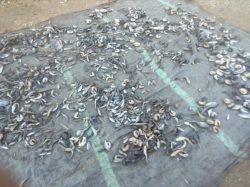By Dr Ibrahim M. Magami, Department of Biological Sciences, UDUS Nigeria
Sokoto State is located in northwestern Nigeria, endowed with freshwater bodies, of which Kware Lake is the only popular natural lake (Fig. 1). The lake is used for daily domestic activities, and washing is common at the shore (Fig. 2), despite the fact that irrigation and fishing activities are routine practices around the lake. Lakes receive water through precipitation, by runoff, groundwater, etc. They differ by origin: landslide, volcanic eruption, etc. (Hutchinson, 1957; Wetzel, 2001).
Kware Lake is invaded with Typha latifolia, also known as cattail grass, which proliferates and dominates the lakeshore (Fig. 3). This invasion causes blockage and siltation around the lake. This grass spreads and is difficult to control.
Instead of allowing this invasion around Kware Lake, T. latifolia could be used to make mats and baskets and stuff cushions and pillows. The leaves are used for thatching, particularly roofing. The plant can also be used as hats, chair seats, building blocks and insulation (Burkill, 2000). The rhizomes of the plant are eaten during famines. The roots and leaves of T. latifolia can be made into a hot drink to relieve stomachache. It could be used for these purposes instead of occupying the shore where irrigation is taking place (Fig. 4) and blocking landing sites for fishing activities in Kware Lake (Fig. 5).
The science of aquatic ecosystems encourages using lakes for a wide variety of purposes; functioning lakes provide a range of benefits (Schallenberg et al., 2014). In addition to other benefits, lakes such as Kware Lake can also contribute to the economy if conserved (Kuusisto and Hyvärinen, 2000). Inhabitants around Kware Lake depend on it as source of income from fishing and irrigation, apart from other domestic uses (Fig. 6-7).
Despite the invasion of T. latifolia, irrigation continues. Government and stakeholders need to develop a way to reduce the amount of T. latifolia,conserve water quality for domestic use, and encourage more irrigation and fishing practices.

References
Burkill, H.M. (2000). The useful plants of West Tropical Africa. 2nd Edition. Volume 5, Families S–Z,
Addenda. Royal Botanic Gardens, Kew, Richmond, United Kingdom. Pp.686.
Hutchinson, G.E. (1957). A Treatise on Limnology. L Geography, Physics and Chemistry. John Wiley and Sons, New York. Pp.1015.
Esko Kuusisto and Veli Hyvärinen (2000).”Hydrology of Lakes”. In Pertti Heinonen. Hydrological and Limnological Aspects of Lake Monitoring. John Wiley & Sons. Pp. 4–5.
Marc Schallenberg, Mary D. de Winton, Piet Verburg, David J. Kelly, Keith D. Hamill and David P. Hamilton. (2014).
Ecosystem Services of Lakes. Ecosystem Services in New Zealand, Newsletter.
Wetzel, R.G. (2001). Limnology. Lake and River Ecosystems. 3rd Edition. Academic Press, San Diego. Pp.1006.















